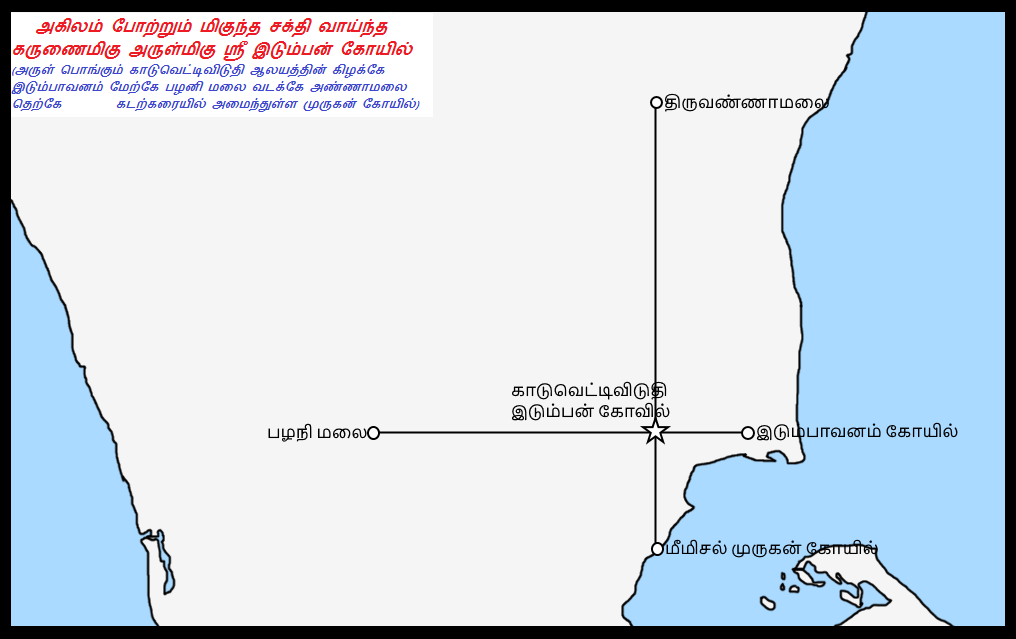Idumban Swami on:
[Wikipedia]
[Google]
[Amazon]
Idumban is a great devotee of Lord
 1. Whosoever carried on his shoulders the Kavadi, signifying the two hills and visited the temple on a vow, should be blessed and;
2. He should be given the privilege of standing sentinel at the entrance to the hill.
Hence, the Idumban shrine halfway is up the hill where every pilgrim is expected to offer obeisance to Idumban before entering the temple of Dandayudhapani. Since then, pilgrims to Palani bring their offerings on their shoulders in a kavadi. The custom has spread from Palani to all Muruga shrines worldwide.
1. Whosoever carried on his shoulders the Kavadi, signifying the two hills and visited the temple on a vow, should be blessed and;
2. He should be given the privilege of standing sentinel at the entrance to the hill.
Hence, the Idumban shrine halfway is up the hill where every pilgrim is expected to offer obeisance to Idumban before entering the temple of Dandayudhapani. Since then, pilgrims to Palani bring their offerings on their shoulders in a kavadi. The custom has spread from Palani to all Muruga shrines worldwide.
File:Kaduveividuhi idumban3.jpg, Idumban at Kaduveividuhi
File:Idumban 01.jpg, Image of Idumban
File:SRILANGA DEVOTEES CAME KADUVETTIVIDUTHY IDUMBAN TEMPLE.jpg, Devotees from Sri Lanka come to the Kaduvettividuthy Murugan Temple, Kaduvettividuthy, Tamil Nadu.
File:Kaduveividuhi idumban4.jpg, Idumban at Kaduveividuhi
File:Kaduveividuhi idumban2.jpg, Idumban at Kaduveividuhi
Idumban History
Idumban History
Idumban and Kavadi
Kaumaram Characters in Hindu mythology
Muruga
Kartikeya ( sa, कार्त्तिकेय, Kārttikeya), also known as Skanda, Subrahmanya, Shanmukha (), and Murugan ( ta, முருகன்), is the Hindu god of war. He is the son of Parvati and Shiva, the brother of Ganesha ...
and a great disciple of sage Agastya
Agastya ( kn, ಅಗಸ್ತ್ಯ, ta, அகத்தியர், sa, अगस्त्य, te, అగస్త్యుడు, ml, അഗസ്ത്യൻ, hi, अगस्त्य) was a revered Indian sage of Hinduism. In the I ...
as well according to Tamil
Tamil may refer to:
* Tamils, an ethnic group native to India and some other parts of Asia
** Sri Lankan Tamils, Tamil people native to Sri Lanka also called ilankai tamils
**Tamil Malaysians, Tamil people native to Malaysia
* Tamil language, nati ...
mythology. Idumban is also seen as one of the guardians of Muruga's temples in Tamil Nadu. During Thai Poosam celebrations in the Tamil month of Thai, Tamil people observe a ritual practice of Kavadi Aattam to obtain blessings from Muruga.In the ritual practice, before entering into the shrine, people used to worship Idumban.
Mythology
SageAgastya
Agastya ( kn, ಅಗಸ್ತ್ಯ, ta, அகத்தியர், sa, अगस्त्य, te, అగస్త్యుడు, ml, അഗസ്ത്യൻ, hi, अगस्त्य) was a revered Indian sage of Hinduism. In the I ...
wanted to take two hills - Sivagiri and Sakthigiri - to his abode in the South, and commissioned his disciple Idumban to carry them. Idumban bore the hills slung across his shoulders in the form of a 'kavadi' or a D-shaped object used to carry many items, one on either side. When he became fatigued by carrying the hills, he placed the 'kavadi' near Palani to take rest. Meanwhile, Muruga had been outwitted in a contest for going round the world. Ganesha had won the prized fruit offered to the winner (or, a mango) by simply going around his parents thinking they alone are equivalent to the world. Long after this, Muruga came sweating on his peacock going 3 times around the world, to find that the prize had already been given away. In anger, the frustrated child left the divine parents and came down to Tiruavinankudi at the Adivaram. Siva pacified him by saying that he (Subrahmanya) himself was the fruit of all wisdom and knowledge. Hence the place was called "Pazham Nee" or Pazhani. Later, He withdrew to the hill and settled there as a recluse in peace and solitude. By seeing Idumban, Muruga decided to test his devotion towards his master Agastya and his determination. When Idumban resumed his journey, he could not lift the hill. Muruga had made it impossible for Idumban to lift it. In the fierce battle that ensued, Idumban was killed but was later on restored to life. Idumban prayed that:
 1. Whosoever carried on his shoulders the Kavadi, signifying the two hills and visited the temple on a vow, should be blessed and;
2. He should be given the privilege of standing sentinel at the entrance to the hill.
Hence, the Idumban shrine halfway is up the hill where every pilgrim is expected to offer obeisance to Idumban before entering the temple of Dandayudhapani. Since then, pilgrims to Palani bring their offerings on their shoulders in a kavadi. The custom has spread from Palani to all Muruga shrines worldwide.
1. Whosoever carried on his shoulders the Kavadi, signifying the two hills and visited the temple on a vow, should be blessed and;
2. He should be given the privilege of standing sentinel at the entrance to the hill.
Hence, the Idumban shrine halfway is up the hill where every pilgrim is expected to offer obeisance to Idumban before entering the temple of Dandayudhapani. Since then, pilgrims to Palani bring their offerings on their shoulders in a kavadi. The custom has spread from Palani to all Muruga shrines worldwide.
Gallery
References
{{Reflist, 30emExternal links
Idumban History
Idumban History
Idumban and Kavadi
Kaumaram Characters in Hindu mythology